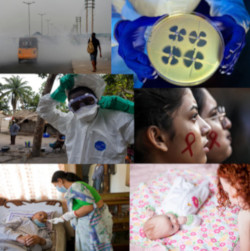
| Jan. 2019 | |||||||||||
| Top stories | |||||||||||
| In the news | |||||||||||
| Photos | |||||||||||
| Contact us | |||||||||||
| Archive | |||||||||||
|
WHO identifies 10 global health threats |
Jan. 29, 2019 --
The world is facing multiple health challenges. These range from outbreaks of vaccine-preventable diseases like measles and diphtheria to drug-resistant pathogens, expanding health impacts of environmental pollution and climate change, and multiple humanitarian crises.

To address these and other threats, 2019 sees the start of the World Health Organization’s new five-year strategic plan – the 13th General Program of Work. Here are 10 of the many issues the WHO identified that "will demand attention from WHO and health partners in 2019."
Air pollution and climate change
Air pollution levels remain dangerously high in many parts of the world with the poorest and the most marginalized bearing the brunt. New WHO data shows nine out of 10 people breathe highly polluted air. Updated estimates show ambient (outdoor) and household air pollution kill seven million people a year.
The State Hygienic Laboratory’s Ambient Air program monitors Iowa’s ambient air quality and, with systems operated by public health departments in Linn and Polk counties, is part of a surveillance network covering all major population and industrial centers in the state.
Non-communicable diseases
Non-communicable diseases, such as diabetes, cancer and heart disease, are collectively responsible for more 70 percent of all deaths worldwide, or 41 million people.
Global influenza pandemic
The WHO predicts that the world will face another influenza pandemic, and says the only thing we don’t know is when it will hit and how severe it will be. Global defenses are only as effective as the weakest link in any country’s health emergency preparedness and response system.
As part of the Iowa Department of Public Health’s Iowa Influenza Surveillance Program, SHL laboratory scientists help determine when and where influenza viruses are circulating in the state and identify the strains of influenza circulating in communities for treatment considerations. The SHL Office of Emergency Preparedness and Response maintains readiness for outbreaks, including an influenza pandemic as it did with the H1N1pandemic in 2009.
Fragile and vulnerable settings
More than 1.6 billion people (22 percent of the global population) live in places where protracted crises (through a combination of challenges such as drought, famine, conflict and population displacement) and weak health services leave them without access to basic care.
Weak primary care systems
Many countries do not have adequate primary health care facilities. This neglect may be a lack of resources in low- or middle-income countries, but possibly also a focus in the past few decades on single disease programs.
In October 2018, WHO co-hosted a major global conference in Astana, Kazakhstan at which all countries committed to renew the commitment to primary health care made in the Alma-Ata declaration in 1978.
While the Hygienic Laboratory’s major commitment is to the health of Iowans, staff members in the past have shown their commitment to worldwide public health by working with the Association of Public Health Laboratories and CDC on projects assisting public health programs in other countries.
Antimicrobial resistance
The development of antibiotics, antivirals and anti-malarials are some of modern medicine’s greatest successes. Now, the effectiveness of these drugs is being tested. Antimicrobial resistance – the ability of bacteria, parasites, viruses and fungi to resist these medicines – threatens to send us back to a time when we were unable to easily treat infections such as pneumonia, tuberculosis, gonorrhea, and salmonellosis.
The State Hygienic Laboratory confirmed more than 30 isolates of carbapenem-resistant Enterobacteriaceae (CRE) in samples submitted from healthcare facilities throughout Iowa in 2017. CRE are considered by the CDC “an immediate public health threat requiring urgent and aggressive action.”
Ebola and other high-threat pathogens
In 2018, the Democratic Republic of the Congo (DR Congo) saw two separate Ebola outbreaks, both of which spread to cities of more than 1 million people. DR Congo is one of the affected provinces that also is in an active conflict zone, further complicating matters.
SHL maintains the capacity to test for Ebola, Zika and other highly infectious diseases. Each year, it also hosts its Wet Workshop to update clinic staff across Iowa about how to work with these pathogens.
Vaccine hesitancy
Vaccine hesitancy – the reluctance or refusal to vaccinate despite the availability of vaccines – threatens to reverse progress made in vaccine-preventable diseases. Vaccination is one of the most cost-effective ways of avoiding disease, currently preventing 2-3 million deaths a year. A further 1.5 million deaths could be avoided if global coverage of vaccinations improved.
SHL tests for influenza in Iowa, and identifies the subtypes and strain of the circulating virus. This information is provided to IDPH and CDC to help determine the content of the flu vaccine for the following year.
Dengue
Dengue, a mosquito-borne disease that causes flu-like symptoms and kills up to 20 percent of those with severe dengue, has been a growing threat for decades. A high number of cases occur in the rainy seasons of countries such as Bangladesh and India. Now, its season in these countries is lengthening significantly (in 2018, Bangladesh saw the highest number of deaths in almost two decades), and the disease is spreading to less tropical and more temperate countries such as Nepal, that have not traditionally seen the disease.
SHL maintains capacity to test for dengue as well as other mosquito-borne diseases, including Zika and West Nile virus.
HIV
Enormous progress has been made against HIV in terms of testing and providing both antiretroviral treatment (22 million), and access to preventive measures including pre-exposure prophylaxis. However, the epidemic continues to rage worldwide with nearly a million people dying of HIV/AIDS every year.
Tests for syphilis are one of the highest volume tests performed by SHL’s Serology section, which also has the expertise to test for HIV.
The State Hygienic Laboratory contributed to this World Health Organization story